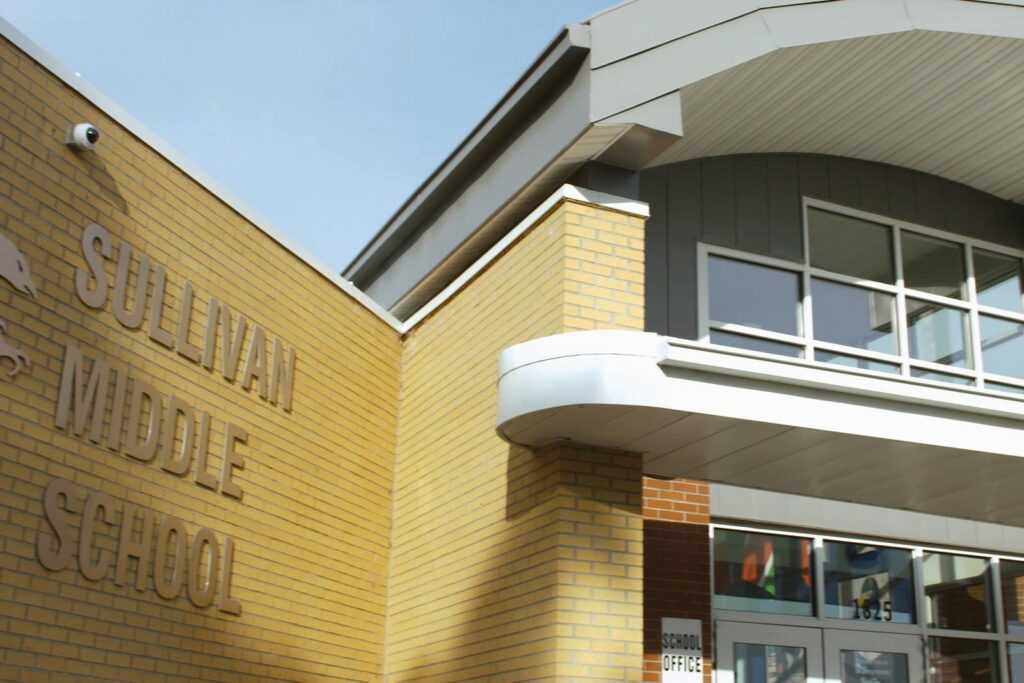School District Increases Safety And Reduces Its Carbon Footprint.

Mission
Rock Hill Schools was looking to upgrade its video surveillance system while aligning with its efforts to reduce energy consumption. Sustainability is an important part of the overall strategy at Rock Hill because it not only saves taxpayer money, but also reduces the school system’s carbon footprint.
A team of Rock Hill administrators determined that a “campus blackout” approach was effective in deterring crime and saving energy. However, the quality of traditional video footage on a dark campus can be an issue and decrease the effectiveness of identifying perpetrators.
Solution
Rock Hill looked at Axis Lightfinder technology that enables video cameras to produce high-resolution, color images in extremely low light. The vast noise reduction capability of Lightfinder delivers sharp, clear, color images in as little light as 0.18 lux (and sometimes less).
In environments with the most challenging light conditions, the team turned to IP cameras with Axis OptimizedIR technology. This technology provides clear images in near complete darkness without additional light sources, which would reveal the camera’s field of view to potential intruders and require additional electricity.
Result
Rock Hill maintains its “campus blackout” approach without sacrificing safety and security. In fact, the security of the school buildings has been enhanced, with a lower number of incidents reported. At the same time, the school district experienced significant electrical savings.
Saving energy wherever possible
Rock Hill School District was looking to upgrade its video surveillance system while aligning with its efforts to save energy. Sustainability is an important part of the overall strategy in Rock Hill because it not only saves taxpayer money, but also reduces the school system’s carbon footprint. Toward this end, Rock Hill Schools employs a full-time Energy Systems Manager, Kim Melander. “With every project, we measure the energy consumption and report to school board and administration,” explained Melander. “We’re always looking for the best application with best efficiency.”
A team of Rock Hill administrators determined that a “campus blackout” approach was effective in deterring crime and saving energy. “We worked with local law enforcement, school administrators, our energy manager and our safety director, looking at technical solutions for our campus,” said Anthony Cox, Deputy Superintendent for the Rock Hill Schools.
“It turns out that the requirement to keep lights on all the time to deter crime is actually somewhat of a myth,” according to Cox. “A lot of research says that keeping the lights off will lower the crime rate.”
Seeing clearly in the dark
The quality of video footage on a dark campus can be an issue. While a blackout policy may reduce crime, it also decreases the effectiveness of traditional surveillance technology to identify perpetrators. Thus, the challenge for Rock Hill was to find a video surveillance system that could operate effectively with high image quality on a dark campus.
Axis Lightfinder technology enables surveillance cameras to produce high-resolution, color images in extremely low light. Incorporating a CMOS sensor with exceptional light sensitivity, cameras that offer Axis Lightfinder can deliver sharp, clear color images in as little light as 0.18 lux (and sometimes less).
In environments with extreme lighting challenges, Rock Hill Schools can still use less LED lighting to meet their efficiency goals. For these areas, the security system utilizes Axis OptimizedIR technology embedded on Power over Ethernet (PoE) cameras. This allows the IR illuminator capabilities inside the camera to draw from the same power source while enhancing image usability in near complete darkness. Without it, the system could need additional illumination that would require more energy and could reveal the camera’s field of view to potential intruders.
Improved safety with significant costs and energy savings
Rock Hill was able to maintain its “campus blackout” approach without sacrificing safety and security. In fact, the security of the school buildings has been enhanced, with a lower number of incidents reported. At the same time, the 27 schools had significant electrical savings. In terms of lighting costs, Rock Hill Schools Energy Systems Manager, Kim Melander estimates that the campus blackout policy can save approximately $3,500 for an elementary school, $7,000 for a middle school and up to $10,000 for a high school.
“The system that had the best crime-deterring capability was also very good with sustainability,” said Cox.
“Safety is first but efficiency is also very important for the taxpayer. Every dollar you’re spending on the operational side, you’re not spending on the academic side. We very much want to keep our cash in the classroom.” In addition, all Axis equipment is designed to be as energy-efficient as possible, further augmenting the school district’s policy to maximize sustainability whenever possible.
This white paper was originally written by Axis.
WSS Integrated Technologies is a proud partner of Axis.
- Enhancing Security with Advanced Technologies: A Deep Dive into Key Terms - July 26, 2024
- The Future of CCTV: Innovations and Trends Shaping Tomorrow - July 19, 2024
- Exploring New Developments in the Security and Life Safety Industry - July 12, 2024
